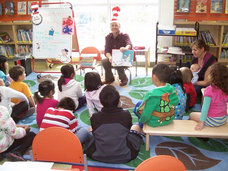As I continue on my journey of integrating more UDL practices into my teaching, sometimes I find it challenging to make time for student self-assessment and reflection. After all, it's not always easy to get through all of the curriculum.
But I need to keep reminding myself that time to reflect and to assess one's own performance allows students to better internalize what they have learned. It also helps us as teachers evaluate students' confidence with the material, and can tell us about what parts of lessons and activities they enjoyed the most (or the least). This information is vital as it can help guide future instruction, and empowers us to continually improve our instruction to benefit our students. Making the time for self-assessment and reflection is worthwhile.
Developing opportunities for students to self-assess and reflect on their learning is a part of CAST's UDL guidelines. According to CAST, this practice is a part of multiple means of engagement, which stimulates interest and motivation for learning. It taps into the affective network of the brain, a.k.a., the "why" of learning. "For many learners, merely recognizing that they are making progress toward greater independence is highly motivating" (CAST, 2011). In The Three Block Model of UDL, by Jennifer Katz, she also argues that self-assessment and reflection is beneficial because it promotes empowerment, and increases student motivation and ownership over learning.
Students love to see evidence of their progress. They thrive on feedback. By providing them with means to reflect on and assess their own learning, we are empowering them to provide their own feedback. Not all feedback needs to come from teachers. We can give students the opportunity to evaluate their own learning, in addition to teacher feedback, to increase the amount and frequency of feedback they receive.
What are some ways we as teachers can increase opportunities for student self-assessment and reflection?
- Exit slips - Students can record them on a post-it and stick on the wall. This is a very easy way for students to self-assess and/or reflect on their learning. They could answer questions such as: "what was your favourite part of today's lesson?", "what are 3 interesting facts you learned today?", "if you had a test on the lesson tomorrow, how do you think you would do?", etc.
- Journals - Teachers can guide student reflection by giving specific prompts, or the prompt could be open-ended.
- Surveys - This could be done in a number of ways. It could be as simple as asking a question and asking students to give a thumbs up or down (or holding up a red, yellow, or green card; or any other variation you can think of). Students could also respond to a survey on paper, or online (http://surveymonkey.com is a good source), or with SMART Senteos.
- Rubrics - Students can be provided with a rubric to grade their own work. This task could be modeled for them by doing a shared activity in which the class looks at a sample of work and then collaborate to grade it based on the criteria set by the rubric.
These are just a few ways that teachers can provide students with more opportunities for self-assessment and reflection. As you can see, they are fairly easy to implement. The hard part is remembering to set aside a small amount of time and working it into instruction before moving onto the next lesson. But we can do it if we set our minds to it!



